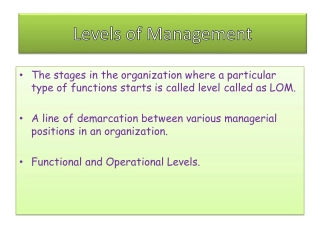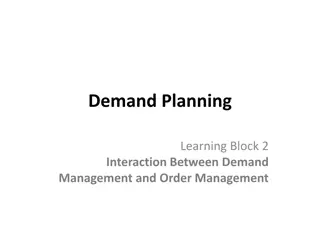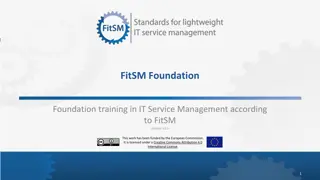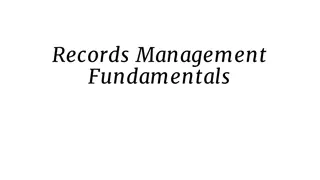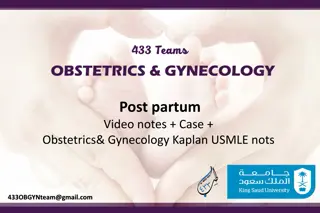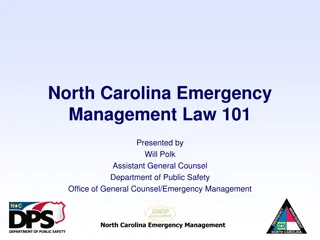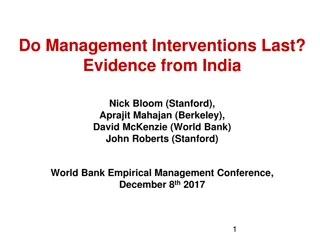Hemorrhoids and Their Management
Hemorrhoids, also known as piles, are dilated blood vessels in the anorectal region. Learn about their types, causes, assessment, when to refer for medical attention, and non-pharmacological management.
Uploaded on Mar 02, 2025 | 0 Views
Download Presentation

Please find below an Image/Link to download the presentation.
The content on the website is provided AS IS for your information and personal use only. It may not be sold, licensed, or shared on other websites without obtaining consent from the author.If you encounter any issues during the download, it is possible that the publisher has removed the file from their server.
You are allowed to download the files provided on this website for personal or commercial use, subject to the condition that they are used lawfully. All files are the property of their respective owners.
The content on the website is provided AS IS for your information and personal use only. It may not be sold, licensed, or shared on other websites without obtaining consent from the author.
E N D
Presentation Transcript
Hemorrhoids Hemorrhoids also known as piles. abnormally dilated, swollen, bulging of hemorrhoidal vessels and the overlying skin in the anorectal region.
Etiology Etiology Anatomical Physiological Mechanical abdomen). Anatomical (degeneration of elastic tissue), Physiological (increased anal canal pressure), Mechanical (increase pressure inside Exacerbated Factors: Exacerbated Factors: Constipation, inadequate dietary fiber or fluid intake. Pregnancy hemorrhoids in susceptible women. Pregnancy is believed to precipitate susceptible women.
Types of hemorrhoids Types of hemorrhoids
Internal Haemorrhoid Grade I canal; Grade II reduce spontaneously; Grade III Grade IV Internal Haemorrhoid Grade I, do not prolapse out of the anal Grade II, prolapse on defecation but Grade III, require manual reduction; and Grade IV, cannot be reduced.
Patient Assessment (Specific questions to ask) Patient Assessment (Specific questions to ask) Duration and previous history Pain (not continuous) Itching ( Bleeding Constipation Associated symptoms appetite, tenesmus (desire to defecate when there is no stool), seepage (involuntary passage of fecal material). Duration and previous history Pain (not continuous) Itching (perianal Bleeding (with stool or not) Constipation Associated symptoms (pain, vomiting, loss of perianal area) area)
When to Refer When to Refer Duration of longer than 3 weeks. Presence of blood in the stools. Change in bowel habit (persisting alteration from normal bowel habit). Suspected drug-induced constipation. Associated abdominal pain/vomiting. If symptoms have not improved with OTC medication after 1 week.
Management Management Non- -pharmacological Advices Increase the amount of fiber and fluid in the diet. Avoid lifting heavy object. Avoid delaying the urge to defecate. Avoid prolonged sitting in the toilet to reduce straining and pressure on the hemorrhoids vessels. Wash the perianal area with warm water after each bowel movement. In addition many patients find that warm bath soothes their discomfort. Non pharmacological Advices
Pharmacological Therapy Pharmacological Therapy
The OTC local products for hemorrhoids Type The OTC local products for hemorrhoids Type Example(s) Example(s) Purpose (and mechanism) Purpose (and mechanism) Anesthetics Anesthetics Lidocaine Lidocaine, , benzocaine benzocaine Reduce Reduce pain pain and and itching itching Astringents Astringents Bismuth, Bismuth, zinc zinc Precipitate producing to to reduce Reduce inflammation and swelling to relief Pain and itching. Form irritation, moisture Antiseptic Precipitate the producing coat reduce itching, Reduce inflammation and swelling to relief Pain and itching. Form a a barrier irritation, itching, moisture. . Antiseptic. . the surface coat over itching, irritation, surface protein over hemorrhoids irritation,.. .. protein hemorrhoids Anti Anti- -inflammatory inflammatory Hydrocortisone (the only OTC) Zinc calamine, Hydrocortisone (the only OTC) Zinc oxide, calamine, shark Protectants Protectants oxide, AL shark liver AL- -hydroxide, liver oil hydroxide, oil barrier on itching, and on skin skin to to prevent and loss prevent loss of of Antiseptics Antiseptics resorcinol resorcinol Counter Counter- -irritants irritants menthol menthol Give overcome Reduce itching Give overcome pain Reduce swelling itching. . tingling pain and swelling to to relief tingling sensation and itching relief pain sensation itching. . to to Vasoconstrictor Vasoconstrictor Phenylphrine Phenylphrine, , ephedrine ephedrine pain and and
Laxatives Laxatives The short-term use of a laxative to relieve constipation might be considered. A stimulant laxative (e.g. senna) could be supplied for 1 or 2 days. dietary fiber and fluids are being increased. For patients who cannot or choose not to adapt their diet, bulk laxatives may be used long term.
Heartburn Heartburn Gastro-esophageal reflux disease (GERD) = Reflux Esophagitis = Heartburn. Reflux of gastric contents, particularly acid, into the esophagus. Typically a burning discomfort/pain felt in the stomach Unlike the stomach lining, the esophageal mucosa has no protection against gastric acid and readily irritated by acid.
Patient assessment with GERD Patient assessment with GERD Age Symptoms Severity of pain Difficulty in swallowing and regurgitation Pregnancy Age Symptoms Severity of pain Difficulty in swallowing and regurgitation Pregnancy
Precipitating or aggravating factors Precipitating or aggravating factors Bending or lying down. Overweight. After large meal. Pregnancy (mechanical and hormonal influence). It can be aggravated or even caused by belching.
Medication Medication What had been tried to treat the condition. Some drugs may cause GERD and may also lead to an increase in existing GERD symptoms and signs: Reduction in lower esophageal sphincter pressure (LESP) (anticholinergics, tricyclic antidepressants). Delayed gastric emptying (calcium channel blockers). Damage or inflammation in the esophageal (NSAID). Some drugs may cause GERD and may also lead to an increase in existing GERD symptoms and signs:
When to refer When to refer Failure to respond to antacids Pain radiating to arms Difficulty in swallowing Regurgitation Long duration Increasing severity Children
Treatment Timescale Treatment Timescale (1 week) Non Non- -pharmacological advices pharmacological advices Eat small and frequent meals Avoid lying down within 3 hours of a meal. Wear loose fitting clothing Avoid smoking of GERD. Weight reduction s small and frequent meals Wear loose fitting clothing Avoid smoking and foods that exacerbate symptoms Weight reduction should be advised.
Pharmacological Treatment Pharmacological Treatment Antacids Alginates H2 antagonists and Ranitidine) Proton pump inhibitors and Antacids Alginates H2 antagonists ( (Cimetidine and Ranitidine) Proton pump inhibitors ( (Omeprazole and Esomeprazole Cimetidine, , Nizatidine Nizatidine, , Famotidine Famotidine Omeprazole, , Lansoprazole Lansoprazole Esomeprazole) )
Indigestion Indigestion Many patients use the terms indigestion and heartburn interchangeably. The discomfort of dyspepsia is variably described as a pain, distension, or feeling of fullness, but is generally not burning in nature.
Patient Assessment Patient Assessment Age Symptoms ( Diet & Smoking Details of pain/ associated symptoms Medication Age Symptoms (upper to lower abdominal discomfort) Diet & Smoking Details of pain/ associated symptoms Medication
Duodenal Ulcer upper abdomen, slightly to the right of the midline. It is often possible to point to the site of pain with a single finger. The pain is dull and is most likely to occur when the stomach is empty It is relieved by food by fatty foods) and antacids. Gastric Ulcer It is often aggravated by food with nausea and vomiting. Appetite is usually reduced and the symptoms are persistent and severe. same site of pain. Duodenal Ulcer Pain is localised to the upper abdomen stomach is empty, especially at night. relieved by food (although it may be aggravated Gastric Ulcer aggravated by food and may be associated
Gallstones Gallstones Stones can become temporarily stuck in the opening to the bile duct as the gall bladder contracts. This causes severe pain (biliary colic) in the upper abdomen. Confused with that of a duodenal ulcer. Biliary colic may be precipitated by a fatty meal.
Gastro Gastro- -oesophageal oesophageal Reflux Reflux The symptoms are typically described as heartburn arising in the upper It is often precipitated by a large meal or by bending and lying down. upper abdomen passing upwards behind the breastbone. large meal or by bending and lying down. Irritable bowel syndrome Pain is often occur in the lower abdominal and therefore confused with indigestion. There is usually an alteration in bowel habit constipation and diarrhoea). Irritable bowel syndrome lower abdominal but it may be upper upper alteration in bowel habit (alternating
Atypical angina Atypical angina Angina is usually experienced as a tight, painful constricting band across the middle of the chest. Atypical angina pain may be felt in the lower chest or upper abdomen precipitated by exercise Appendicitis Starts centrally and radiates to right lower chest or upper abdomen. It is likely to be exercise or exertion. Appendicitis centrally and radiates to right iliac fossa after some time. More serious disorders More serious disorders Persisting upper abdominal pain with anorexia and unexplained weight loss. Ulcers start bleeding, which may present with blood in the vomit (haematemesis) or in the stool (melaena).
When to refer When to refer Age over 45 years if symptoms develop for first time Symptoms are persistent (longer than 5 days) or recurrent Pain is severe Blood in vomit or stool Pain worsens on effort Persistent vomiting Treatment has failed Adverse drug reaction is suspected Associated weight loss Children
Treatment timescale 5 days Treatment timescale Antacids H2 antagonists Dimeticone Domperidone Antacids H2 antagonists Dimeticone Domperidone
The The position of pain in ulcers position of pain in GERD The position of pain in appendicitis The The position of pain in gallstone position of pain in dyspepsi a


